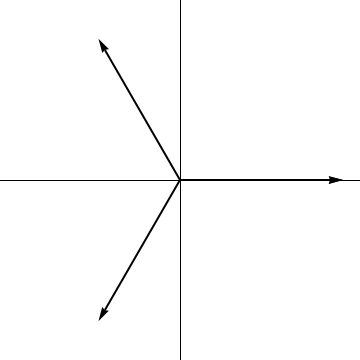I only show how to obtain the C-G coefficients for the two states $|\frac{1}{2},\frac{1}{2}\rangle_1$ and $|\frac{1}{2},\frac{1}{2}\rangle_2$.
First, it is easy to see that $|\frac{3}{2},\frac{1}{2}\rangle=\frac{1}{\sqrt{3}}(|-++\rangle+|+-+\rangle+|++-\rangle)$.
By writing $|\frac{1}{2},\frac{1}{2}\rangle_i=\alpha_i|-++\rangle+\beta_i|+-+\rangle+\gamma_i|++-\rangle$ ($i=1,2$), then the matrix
$U=\left(
\begin{array}{ccc}
\frac{1}{\sqrt{3}} & \alpha_1 & \alpha_2 \\
\frac{1}{\sqrt{3}} & \beta_1 & \beta_2 \\
\frac{1}{\sqrt{3}} & \gamma_1 & \gamma_2 \\
\end{array}
\right)$ should be an orthogonal matrix, due to the normalization of $|\frac{1}{2},\frac{1}{2}\rangle_1$ and $|\frac{1}{2},\frac{1}{2}\rangle_2$, and the fact that the three states with same $m$, $|\frac{3}{2},\frac{1}{2}\rangle$, $|\frac{1}{2},\frac{1}{2}\rangle_1$, and $|\frac{1}{2},\frac{1}{2}\rangle_2$, should be mutually orthogonal.
We thus have
\begin{eqnarray}
&&\alpha^2_i+\beta^2_i+\gamma^2_i=1,\\
&&\alpha_i+\beta_i+\gamma_i=0,\\
&&\alpha_1\alpha_2+\beta_1\beta_2+\gamma_1\gamma_2=0
\end{eqnarray}
By eliminating $\gamma_i$ from the first two equations, we get $ \alpha^2_i+\alpha_i\beta_i+(\beta^2_i-\frac{1}{2})=0$, which gives $\alpha_i=\frac{1}{2}(-\beta_i\pm\sqrt{2-3\beta^2_i })$. So we have
\begin{eqnarray}
(\alpha_i,\beta_i,\gamma_i)=\left(\frac{1}{2}(-\beta_i\pm\sqrt{2-3\beta^2_i }),\beta_i,\frac{1}{2}(- \beta_i\mp\sqrt{2-3\beta^2_i })\right)
\end{eqnarray}
Now we can choose
\begin{eqnarray}
(\alpha_{1/2},\beta_{1/2},\gamma_{1/2})=\left(\frac{1}{2}(-\beta\pm\sqrt{2-3\beta^2 }),\beta,\frac{1}{2}(- \beta\mp\sqrt{2-3\beta^2 })\right)
\end{eqnarray}
so that the orthogonal condition $\alpha_1\alpha_2+\beta_1\beta_2+\gamma_1\gamma_2=0$ gives
\begin{eqnarray}
\frac{1}{4}(\beta^2-2+3\beta^2)+\beta^2+\frac{1}{4}(\beta^2-2+3\beta^2)=0\to3\beta^2-1=0\to\beta=\pm\frac{1}{\sqrt{3}}
\end{eqnarray}
By choosing $\beta=\frac{1}{\sqrt{3}}$, we finally obtain
\begin{eqnarray}
|\frac{1}{2},\frac{1}{2}\rangle_1&=&\frac{1}{2}(1-\frac{1}{\sqrt{3}})|-++\rangle+\frac{1}{\sqrt{3}}|+-+\rangle-\frac{1}{2}(1+\frac{1}{\sqrt{3}})|++-\rangle,\nonumber\\
|\frac{1}{2},\frac{1}{2}\rangle_2&=&\frac{1}{2}(1+\frac{1}{\sqrt{3}})|-++\rangle-\frac{1}{\sqrt{3}}|+-+\rangle-\frac{1}{2}(1-\frac{1}{\sqrt{3}})|++-\rangle.
\end{eqnarray}
Other choices appearing in previous answers do not satisfy the condition $\alpha_1\alpha_2+\beta_1\beta_2+\gamma_1\gamma_2=0$ [for example $(\alpha_{1/2},\beta_{1/2},\gamma_{1/2})=\left(e^{\mp 2\pi i/3},e^{\pm 2\pi i/3},1\right)$ or $(\alpha_{1},\beta_{1},\gamma_{1})=\frac{1}{\sqrt{6}}\left(-2,1,1\right)$ and $(\alpha_{2},\beta_{2},\gamma_{2})=\frac{1}{\sqrt{6}}\left(-1,-1,2\right)$].
Another choice of $(\alpha,\beta,\gamma)$ can be found in the following lecture note (P48):
https://public.lanl.gov/mparis/qmp.pdf
There,
\begin{eqnarray}
|\frac{1}{2},\frac{1}{2}\rangle_1&=&-\frac{1}{\sqrt{2}}|-++\rangle+\frac{1}{\sqrt{2}}|+-+\rangle,\nonumber\\
|\frac{1}{2},\frac{1}{2}\rangle_2&=&-\frac{1}{\sqrt{6}}|-++\rangle-\frac{1}{\sqrt{6}}|+-+\rangle+\frac{2}{\sqrt{6}}|++-\rangle.
\end{eqnarray}
are chosen. I just noticed that these are already mentioned in Emilio Pisanty's answer above.
This is possible since we have 6 unknowns and only 5 constraints, so the solutions are not unique.
As stated in the above reference, the additional quantum number to resolve the degeneracy is just the permutation operator between spin 1 and spin 2, $P_{12}$: $P_{12}|\frac{1}{2},\frac{1}{2}\rangle_{1,2}=\mp |\frac{1}{2},\frac{1}{2}\rangle_{1,2}$.
It is easy to see that $|\frac{1}{2},\frac{1}{2}\rangle_{1,2}$ are also eigenstates of $\vec{S}_1\cdot\vec{S}_2$, with eigenvalues $-\frac{3}{4}$ and $\frac{1}{4}$, respectively.


